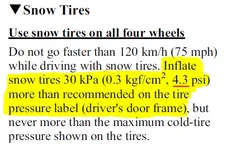optical_man
Member
- :
- 2016 CX-5 GT AWD + tech
Interesting, something that I never knew:
In the 2016 CX-5 manual, it states that the tire pressure for snow tires should be set 4.3 PSI higher than the door sticker pressure label:
Tire Rack explains some reasons why here:
In the 2016 CX-5 manual, it states that the tire pressure for snow tires should be set 4.3 PSI higher than the door sticker pressure label:
Tire Rack explains some reasons why here:

